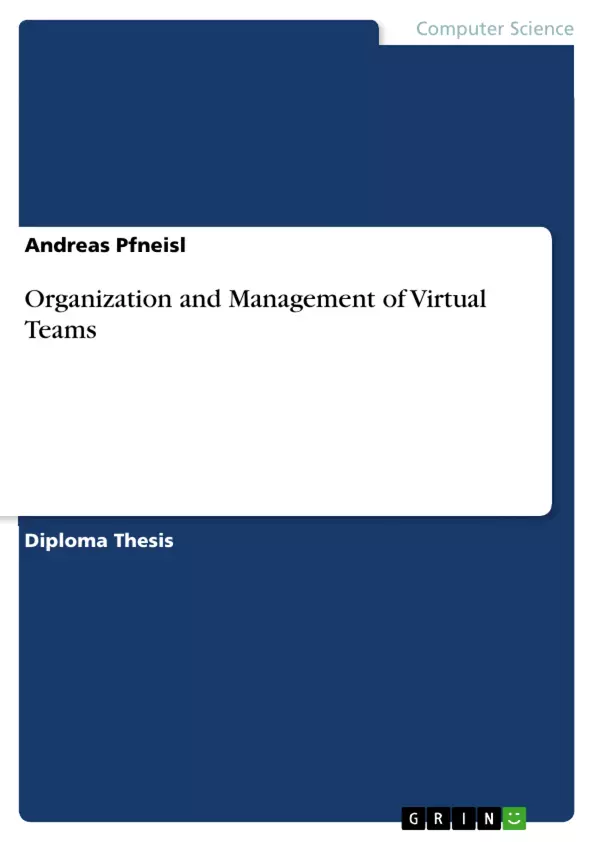The idea to write my master’s thesis on “Organization and Management of Virtual Teams” arose during the 6th term of my studies, which was an exceptional term in many ways.
I was part of several teams then, which is nothing extraordinary, I guess. What made those teams special were the people I was working with – or better – I got the possibility to work with.
I had worked in teams before in the course of my studies and had had some really bad experience with lazy and unproductive people, who simply couldn’t or did not want to identify with tasks and goals of various projects.
What was so special with those teams in the summer term of 1999 was, that most of the team members could identify with the goals set, they worked, they tried really hard to stick to deadlines and targets, they took justified criticism as positive feedback, they were punctual, they communicated and so on – in short: I was part of some very, very productive, purposeful teams (one of the results was that I did my most successful term that term – the work of nearly two terms during this one).
Well, two seminars during this spring were dealing with the topic “Virtual teams” and I got really interested in. So I decided to do my master’s thesis on this subject. I found a nice and easy going supervisor who was interested in the topic, as well, and I started to write on the thesis at the end of my stay in Stockholm, Sweden, as an ERASMUS exchange student.
But why this topic, why a thesis on virtual teams? Several reasons should be mentioned:
My interest in the topic: Since I am studying “Wirtschaftsinformatik” (Economical Computer Science, a mixture between economics and computer science), I am interested in both economics and technology. What topic suits that combination better than “Virtual Teams”, which have to work for economic reasons across distances and organizational borders – all this with the help of the latest technology.
The challenge: Not a lot was written about the subject “Virtual Teams” when I started to look for literature suitable for my thesis. I hardly could find books in Sweden and the ones I finally chose I had to order from the US (which is also a reason why this thesis is written in English, because all the literature I used was written in English). So it was quite a challenge (but exciting) to write about something new...
Inhaltsverzeichnis (Table of Contents)
- Organization and Management of Virtual Teams
- The Idea
- Relevance to the present situation
- The Thesis at one Glance
- What are Virtual Teams and what are they good for?
- The Concept of a Virtual Team
- Reasons for the Development of Virtual Teams
- Advantages and Disadvantages
- Virtual Teams and the Future
- Organization and Management of Virtual Teams
- Virtual vs. Collocated Teams
- Importance of Vision and Goals
- Leadership in Virtual Teams
- Roles and Responsibilities
- Team Size and Composition
- Trust
- Importance of Trust in Virtual Teams
- Building Trust in Virtual Teams
- Factors Affecting Trust in Virtual Teams
- Communication and Collaboration
- Communication Media Palette
- Choosing the Right Communication Media
- Collaboration Tools and Techniques
- SOHO - Small Office / Home Office
- Definition of SOHO
- Emergence and Development of SOHOs
- Challenges and Opportunities of SOHOs
Zielsetzung und Themenschwerpunkte (Objectives and Key Themes)
This thesis aims to explore the organization and management of virtual teams, examining their development, benefits, challenges, and key aspects such as communication, trust, and leadership.- The emergence and evolution of virtual teams in a globalized business environment.
- The unique challenges and opportunities associated with managing virtual teams, including communication, trust, and cultural differences.
- The key factors contributing to the successful organization and management of virtual teams, such as effective communication strategies, building trust, and establishing clear goals and leadership roles.
- The role of technology in facilitating virtual team collaboration and communication.
- The implications of virtual teams for individual employees, teams, and organizations.
Zusammenfassung der Kapitel (Chapter Summaries)
This section will focus on the main themes, arguments, or narrative elements of each chapter, excluding the conclusion or any sections containing major revelations or spoilers.- Chapter 1: Introduction - Discusses the rise of virtual teams as a response to globalization and technological advancements, highlighting the challenges and opportunities of this new work model.
- Chapter 2: What are Virtual Teams and What are they Good For - Defines the concept of virtual teams, explores reasons for their emergence, and discusses the advantages and disadvantages of this form of organization.
- Chapter 3: Organization and Management of Virtual Teams - Compares virtual and collocated teams, emphasizing the importance of vision, goals, leadership, and team composition in virtual team dynamics.
- Chapter 4: Trust - Examines the significance of trust in virtual teams, exploring how to foster trust and identifying factors that can hinder it.
- Chapter 5: Communication and Collaboration - Investigates the role of communication media in virtual teams, offering guidance on selecting the most suitable tools for different situations and highlighting essential collaboration techniques.
- Chapter 6: SOHO - Small Office / Home Office - Provides a brief overview of SOHOs, including their definition, development, challenges, and opportunities, emphasizing their relevance to the broader concept of virtual teams.
Schlüsselwörter (Keywords)
This thesis explores the concepts of virtual teams, globalization, technology, communication, trust, leadership, collaboration, and organizational management. It examines the challenges and opportunities associated with organizing and managing virtual teams in a global business environment.- Quote paper
- Andreas Pfneisl (Author), 2001, Organization and Management of Virtual Teams, Munich, GRIN Verlag, https://www.grin.com/document/185666



